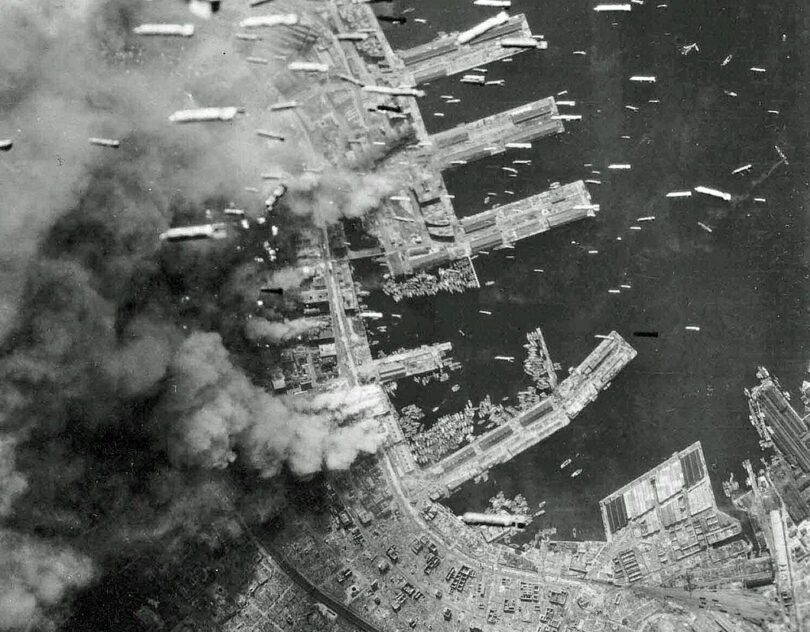by KYLE FERRANA

Every winter, I enjoy attending the Studio Ghibli film festival at the Oregon Museum of Science and Industry. There’s a great nostalgia among certain Americans these days, a desire to relive pieces of their turn-of-the-millennium childhood and I won’t pretend to be an exception. Seeing classic films like Porco Rosso and Princess Mononoke on the IMAX screen can recreate what that time meant for many of us, for just a little while, and catching The Boy and the Heron this year was almost as magical. There’s one such film the museum shows that I’ll probably only see once, though: Isao Takahata’s 1988 masterpiece The Grave of the Fireflies.
Those who have seen it understand why. But if audiences everywhere find it difficult to sit through its characters’ gut-wrenching fate, it’s no less difficult here to confront the how Takahata portrays Americans in his film. That is, not at all—only as the faceless, indifferent operators of distant terror machines that rain down fire on women and children from the sky. It’s not very comforting to realize that this is how much of the world still sees us.
Japan today is an occupied country. U.S. military planes and helicopters enjoy exclusive access to much of its airspace and have passed overhead for decades after the events depicted in the film. The Japanese government, perpetually controlled by the U.S.-backed Liberal Democratic Party, is compelled to defray the cost of a U.S. garrison of fifty thousand troops within its borders, most of which abide menacingly in the southwestern Ryukyu Islands (also known as Okinawa), where they are notorious for their abuses.1 Only this summer, news broke that the government had covered up five sex crimes committed by U.S. soldiers in Okinawa Prefecture just since last year, one of which involved the kidnapping and sexual assault of a minor, most of which had gone unprosecuted.2 Similar incidents have occurred throughout at least the past few decades in Japan, as well as in South Korea, which also hosts tens of thousands of U.S. soldiers and the largest overseas U.S. military base at Camp Humphreys.3
We know why the Ryukyuans and Koreans suffer—so we could fight Russia. And then China. Then North Korea, then China, then Vietnam, then China, and then Russia again, but always and now especially China. Japan’s ideal strategic location commands the coast of East Asia, and the United States has waged open warfare or economic siege all along that coast for half a century. With the same bland indifference as the warplanes of 1945, the U.S. high command has acknowledged that it ended the lives of one million Korean civilians in the early 1950s.4 Hundreds of thousands of Cambodians and Laotians were killed by the U.S. Air Force in the same manner in the 1960s and ’70s, and millions of acres of the Vietnamese jungle were defoliated with chemical weapons that continue to kill today. Google “Agent Orange hydrocephalus.” You won’t thank me.
Of course, there is no end of propaganda in the United States, then and now, to justify all this mass murder, explicitly or otherwise. Korea and Vietnam had invaded themselves—surely, we couldn’t stand by and let such a thing happen? Even prominent members of Congress still publicly defend the atomic bombing of Japanese civilian populations as necessary to end the war in the Pacific, ignoring a growing consensus among historians, based partly on the now-available Soviet archives, that the Soviet Union’s offensive against Japanese-controlled Manchuria was far more concerning to Japan’s wartime leaders than atomic weapons.5 It is, unfortunately, quintessentially American to believe that foreign countries will only respond to force and can only be truly intimidated by a really big bomb.
As you read these words, the drums of war are beating again. China and North Korea, we are told, are escalating tensions, issuing new threats and provocations, performing more military exercises, and conducting more missile tests. Seldom is it mentioned why such escalations are happening. They don’t seem to have a cause at all; they could not possibly be countermoves in response to escalations by the United States, because nothing the United States does can be in any way escalatory.
Monthly Review Online for more
